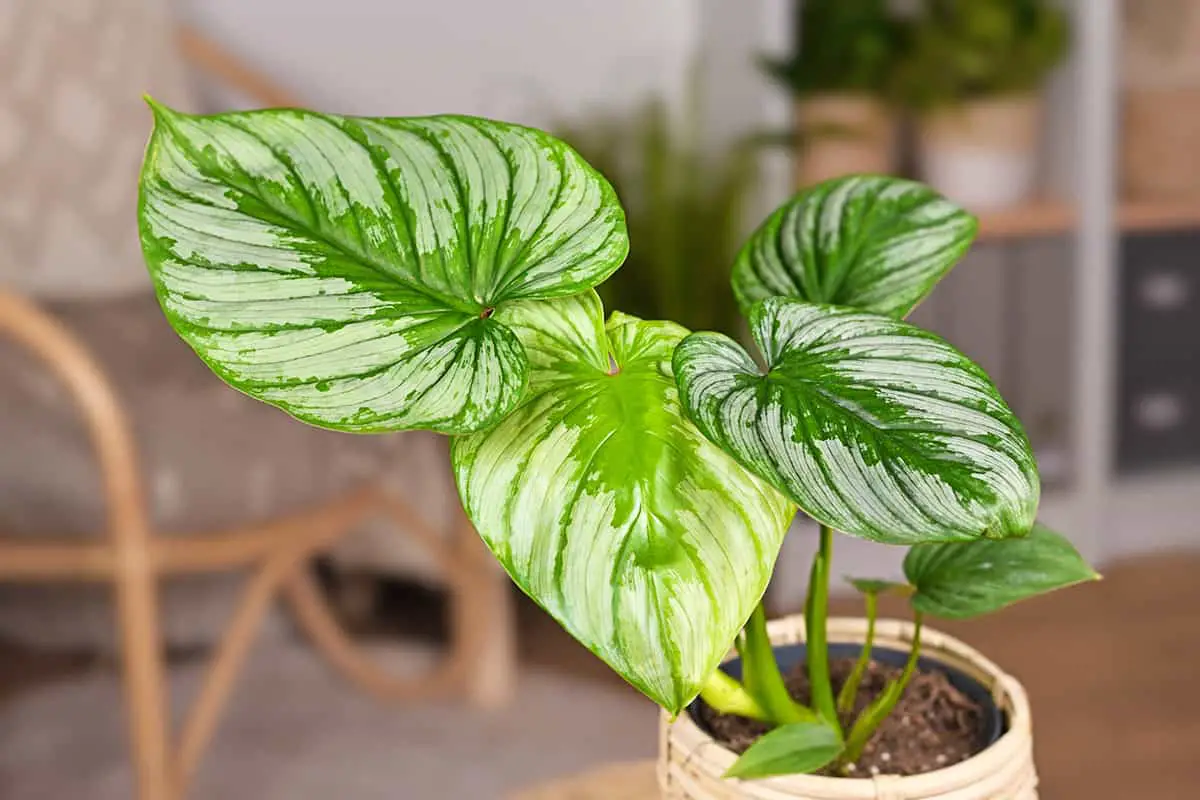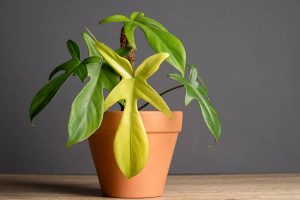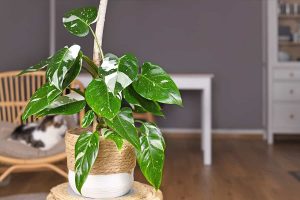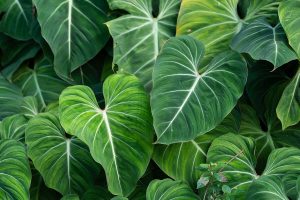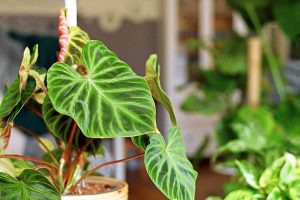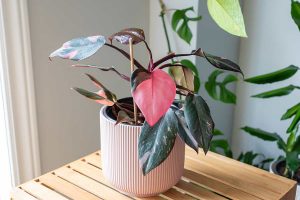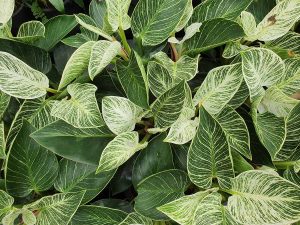This plant is native to Ecuador, where it grows only along the eastern slope of the Andes. As a creeper its habitat is predominantly the forest floor, though it will also start to climb up the base of trees and other plants.
It makes for a popular houseplant, thanks to its striking foliage and trailing habit. Let the vines dangle from a hanging planter or over the side of a shelf for the most dramatic effect.
| Botanical name | Philodendron Mamei |
| Common names | Blotched Philodendron, Silver Cloud, Quilted Silver Leaf |
| Plant family | Araceae |
| USDA hardiness zone | 9- 11 |
| Mature height | 4 feet |
| Mature spread | 3 feet |
Table of Contents
How to Care for Your Philodendron Mamei
The Philodendron Mamei is one of the rarer types of Philodendrons grown as a houseplant, which can make it more difficult to find, and more expensive to purchase. However, many plant enthusiasts cannot resist the unusual foliage this plant has to offer, with silver-colored variegation set against a dark green background and an almost quilted effect.
This plant can also be grown outside in hot climates. Whether you are keeping the Philodendron Mamei as a houseplant or an outdoor specimen, you will need to follow these care guidelines.
Light
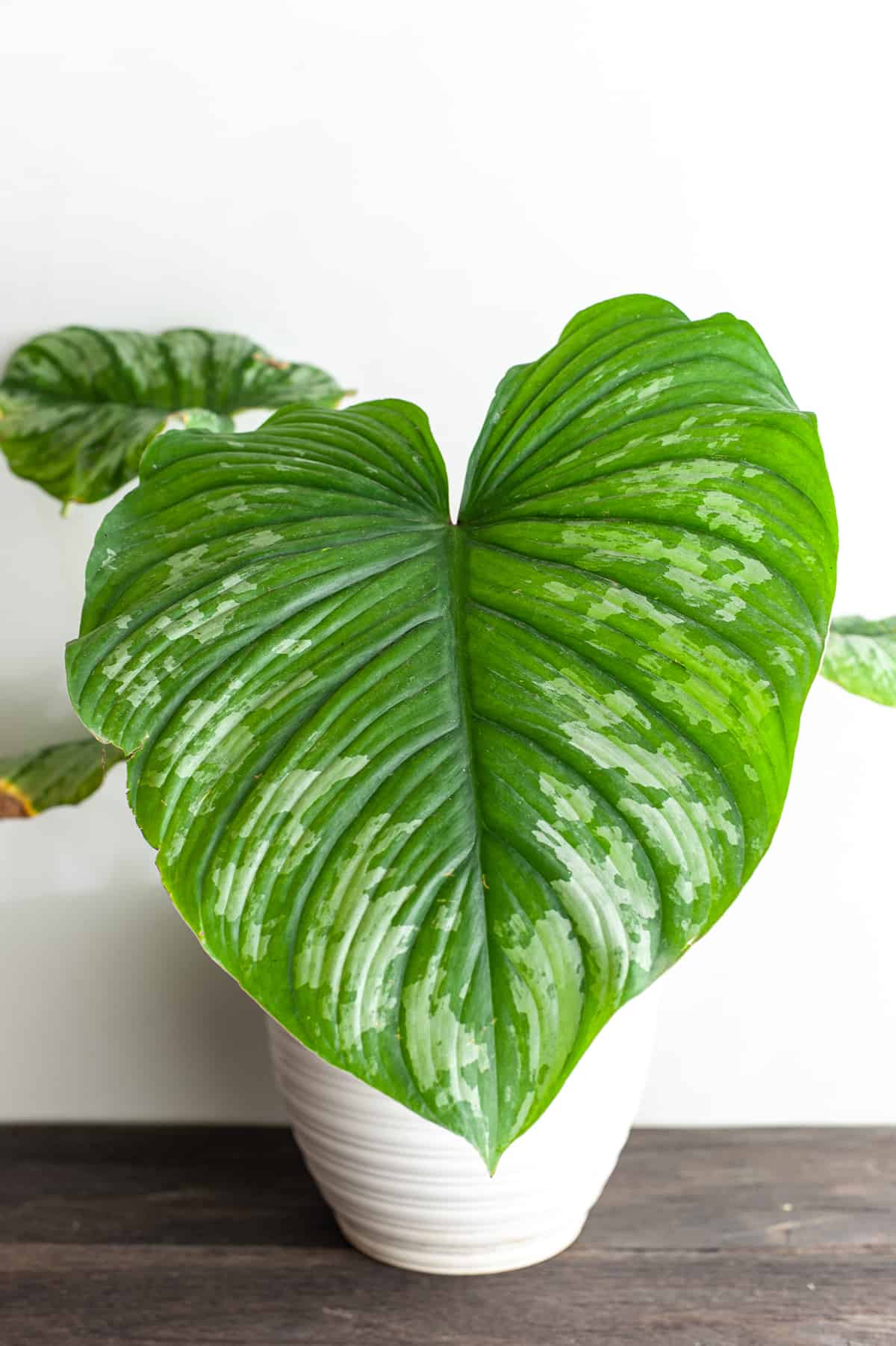
In its natural habitat, the Philodendron Mamei grows along the ground of the forest, where it will be shaded by the canopy of taller plants and trees. Often this plant will be found living in complete shade, though predominantly, it thrives in dappled light.
It is not accustomed to direct bright light, so this type of aspect should be avoided when growing the Philodendron Mamei as a houseplant or in the garden. This plant will adapt to varying levels of shade, but for the best results, you should aim for exposure to bright, indirect light.
Ideally, this would be on an east or west-facing windowsill or in a south-facing aspect with blinds or sheer drapes at the window to filter the light. Direct light will cause the leaves to scorch, while a lack of light can cause the plant to become stunted.
Since the foliage of this plant is variegated, it requires more sunlight than non-variegated plants in order to photosynthesise. When grown outside, position this plant beneath a tree or large shrub, where it can shelter from direct light and also benefit from dappled light.
Water
The Philodendron Mamei is accustomed to a moist environment, often growing along the side of streams and on riverbanks in its natural habitat. When kept as a houseplant, you should aim to replicate these conditions to ensure the best growth for your plant.
Maintain consistently moist soil by watering it regularly while also ensuring that the soil doesn’t become too wet. To do this, let the top few inches of soil dry out in between waterings, but never let the entire pot of soil dry out.
You can expect that a medium-sized Philodendron Mamei will need to be watered once a week during spring and summer when the plant is in its rapid growth phase and the daylight hours are longer, and this should be reduced to once or twice a month during the remainder of the year.
The Philodendron Mamei is quite a thirsty plant, but take precautions to avoid overwatering because this will inevitably lead to root rot and the death of the plant.
Temperature
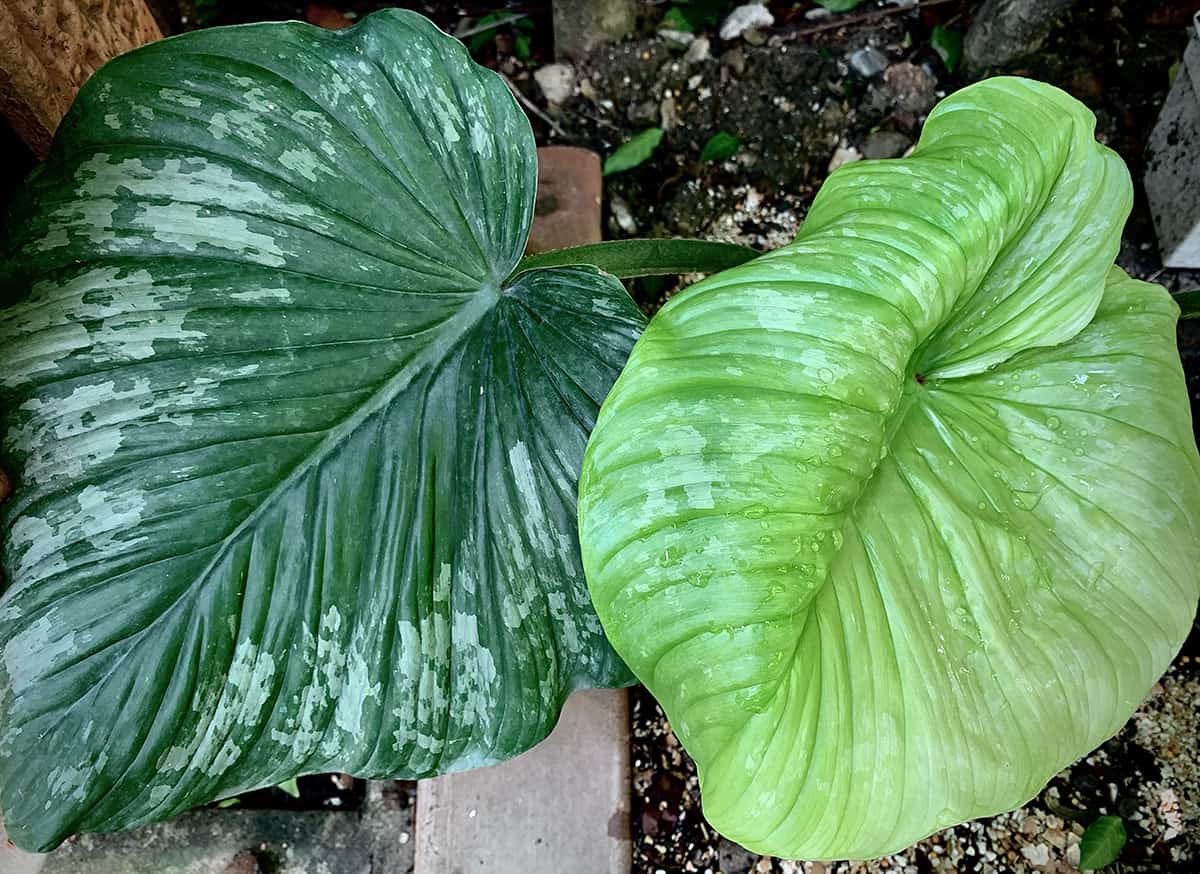
This plant enjoys a warm environment, which makes it perfect for growing as a houseplant. The average room temperature of homes falls within the same temperature range that tropical plants experience in the wild, so they are very comfortable being grown indoors.
Any temperature between 65 and 80°F will be acceptable for the Philodendron Mamei, but commonly the room temperature in a home is around 68°F. Avoid letting the temperature drop lower than 55°F because this will cause the plant to go into shock and a state of hypothermia.
This means you should remember to leave the heating on in your home if you go on vacation during the winter, otherwise, your Philodendron Mamei will probably be dead by the time you get home. Also, avoid positioning it close to open windows or doors where a cold draught could affect the plant.
Humidity
The Philodendron Mamei is a plant that relies on high levels of humidity to thrive. The average humidity level in a home is around 30%, but you should be aiming to achieve between 50 and 80% humidity to keep your Philodendron Mamei in tip-top condition. In its natural habitat, the plant is accustomed to very high levels of humidity, so this should be replicated as much as possible when it is grown as a houseplant.
Ideally, keep your Philodendron Mamei in the bathroom since this is the most humid area of any home. The air will have a higher moisture content due to the consistent use of the shower, bath tub, and bathroom sink.
Do not place the Philodendron Mamei in a guest bathroom or other rarely used bathroom, as the humidity in these spaces will not be high enough. If you can’t keep the plant in a humid bathroom, you can create higher humidity levels around the plant by spritzing it with a water spray daily or using a water pebble tray.
If you prefer a low-maintenance option, invest in an electric humidifier that can be plugged in at the mains in the same room as the plant. Another tactic you can use is to group tropical plants together, as this will also increase humidity slightly.
Soil
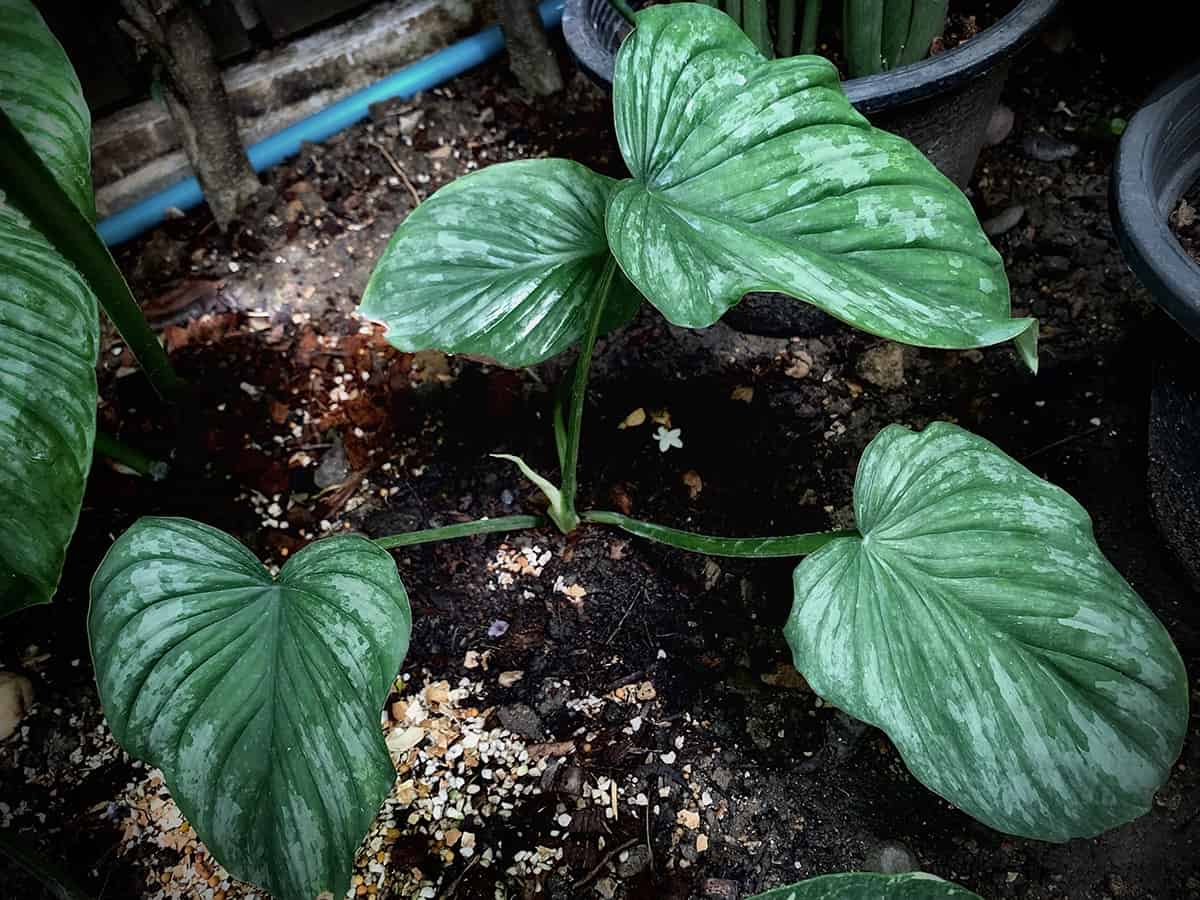
The Philodendron Mamei needs to be grown in well-draining soil so that excess moisture is not held against the roots for an extended period of time. When growing the plant outside, mix sand into your garden soil to improve drainage, or for houseplant soil, mix in orchid bark, perlite, or coconut husks.
A good proportion of organic matter in your soil will also be beneficial to the Philodendron Mamei, which is hungry for nutrients.
Philodendron Mamei FAQs
Is the Philodendron Mamei toxic?
This is a toxic plant that contains calcium oxalate crystals. If you have pets or young children who might be tempted to nibble on the plant, then ensure it is kept out of reach, for example, on a high shelf. The Philodendron Mamei is unlikely to cause fatalities; however, the symptoms associated with consuming even small amounts of this plant are quite unpleasant.
Signs that your pet or child has eaten some of the plants include swelling of the mouth and throat, stomach pain, and vomiting. If a pet is caught eating this plant, seek the advice of a vet.
How big does the Philodendron Mamei get?
In its natural habitat, you can expect to see this plant growing to heights of 4 or 5 feet. However, this is not likely when the Philodendron Mamei is grown as a houseplant. It will typically grow to a maximum of 3 feet when kept indoors, with a spread of 2 feet.
Although the plant itself is not huge, the leaves are quite sizable and therefore make a dramatic impact. Each leaf grows to a typical length of 15 inches with a width of 11 inches.
Are Philodendron Mamei easy to grow?
These make great house plants because they are really easy to grow. They aren’t too fussy about the type of care they receive as long as they are positioned in an appropriate spot and enjoy higher-than-usual rates of humidity. These plants are also fast-growing, so they reward you with the production of plenty of beautiful new leaves to enjoy.
Can you propagate Philodendron Mamei?
If you want to create more Philodendron Mamei plants, this can be achieved with propagation, and the good news is that it is quite simple. Even if you have never propagated a plant before, you should give this a try because it is very rewarding to produce new plants from nothing but a cutting of your existing plant. To propagate the Philodendron Mamei, prune a stem cutting from the mother plant.
This should include at least one leaf and a part of a stem that has a node on it. Plant the raw cut piece of the stem directly into some soil, and set it in a sunny and warm spot. A windowsill with an east or west-facing aspect will be ideal. Ensure the soil remains moist but not wet, and wait a few weeks for the stem cutting to develop roots. It may also begin to produce new leaves, which is a sure sign that your cutting is thriving.
The best time to propagate this plant is during spring since this is just before the plant’s period of rapid growth begins. The chances of propagation success are much higher in the spring. You may be able to propagate from stem cuttings at other times of the year, though it typically will take longer, creating a higher chance that the stem will rot before it produces new roots.
